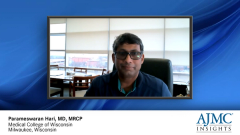
Triple-Class Exposed Relapsed and Refractory Multiple Myeloma
Dr Madduri discusses triple-class exposed relapsed and refractory multiple myeloma.
Episodes in this series

Deepu Madduri, MD: Let’s talk about the landscape for relapsed/refractory multiple myeloma [RRMM]. Patients typically are given PIs [proteasome inhibitors], IMiDs [immunomodulatory imide drugs], and the anti-CD38 antibodies as their first-line therapy, following the approval of daratumumab being used in the front line. Using early use of efficacious regimens to achieve and sustain remissions is critical. However, we know that multiple myeloma [MM] is an incurable disease, and we’re seeing that more and more people are relapsing. It’s hard because the percentage of patients getting to the nth [subsequent] line of therapy diminishes over time, as does the median duration of the nth line of therapy. When we have these relapsed and refractory myeloma patients, despite having 7 classes of antimyeloma agents, we haven’t seen a plateau in the myeloma overall survival [OS] curves.
One of the things that we do now, we have a new addition of XPO1 inhibitors, such as selinexor. We have ADCs [antibody-drug conjugates] that are approved, with one being blenrep [belantamab mafodotin]. We also have HDAC [histone deacetylase] inhibitors, and we have a drug called isatuximab that’s been recently approved as another anti-CD38. Overall, we prescribe a combination of those drugs in addition to possibly enrolling these patients on clinical trials.
Honestly, for a patient with RRMM, if we can get them on a trial, that would be the best-case scenario. Specifically, there are bispecific antibody trials, antibody-drug conjugate trials, and CAR [chimeric antigen receptor] T-cell therapy trials that we can do along with other agents that are being explored.
What defines a triple class-exposed patient? A triple class-exposed patient is someone who has had treatment with an IMiD, such as Revlimid [lenalidomide], pomalidomide, or thalidomide. Additionally, they will have had exposure to a PI, such as Velcade [bortezomib] or carfilzomib, and an anti-CD38, such as daratumumab or isatuximab. Typically, when you have a triple class-exposed patient, they’ve had 1 PI, 1 IMiD, and 1 anti-CD38 in one of these drug combinations as mentioned earlier.
Considering a typical patient with relapsed/refractory myeloma, there’s no clear picture of what they look like. You can have patients who’ve had 4 or 5 prior lines and still look healthy, so that when you see them on the street you may think there’s nothing wrong with them with no obvious signs of them having undergone chemotherapy. Comparatively, you may see some patients where their kidney status is affected because of the light chains, where they may be on dialysis or they may have renal insufficiency where their kidney is not functioning as well. Typical MM is a [disease] of the elderly where the median age is about 65, so if you have somebody who’s had multiple lines of therapy and has been on treatment for a while, they could be in their late 60s or 70s. We’ve seen myeloma diagnoses in patients as young as 30 to 50 years old. I believe there’s no clear age for this relapsed/refractory myeloma, but overall, these are your general population of patients in their 60s who may have underlying diabetes or have underlying hypertension or heart disease. That aside, it can affect anybody, at any time and at any point in life.
The way we measure success in the treatment of RRMM is how long is the median duration of this new therapy? If I’m giving a new therapy for this patient, I want to see that they have longer PFS [progression-free survival]. As we know based upon observations from the past, as the patients get to the nth line of therapy, their median durations get shorter and shorter as you get into more and more relapses, so we want to be able to give them agents that are going to help prolong their disease-free survival [DFS] or their PFS. Eventually, we want to see a change in their median OS and that it gets extended longer and longer.
The reason we need deep and durable responses is because we know that MM is an incurable condition. We want to do whatever we can for our patients to help them see some sustained, deep, and durable responses. Beyond the deep and durable, we need a sustained response, because we may see that a patient goes into remission after their fifth line of therapy, or they received CAR T therapy or a bispecific and you see that their numbers have gone down. However, what we really want to see is that deep, durable response that’s sustained. You want them to have a prolonged DFS and PFS, thus we want to make sure that for whatever deep remission that we’re getting, patients also keep that remission for as long as possible.
What are the outcomes in a triple class-refractory patient? As based on a recent MAMMOTH study, we saw that patients with relapsed/refractory myeloma have a poorer OS in their outcome. Patients who are triple- and quad-refractory have a median OS of less than 9.2 months, and patients who are penta-refractory have a median OS of 5.6 months. Penta-refractory is defined as someone who has had 2 IMiDs, 2 PIs, and an anti-CD38. We know that the more therapies you have, the OS shortens. So, if you’re triple-refractory, your median OS is 9.2 months, and if you’re penta-refractory, your median OS is 5.6 months. Therefore, we really need new therapies that can target this high unmet need.
Newsletter
Stay ahead of policy, cost, and value—subscribe to AJMC for expert insights at the intersection of clinical care and health economics.



























































